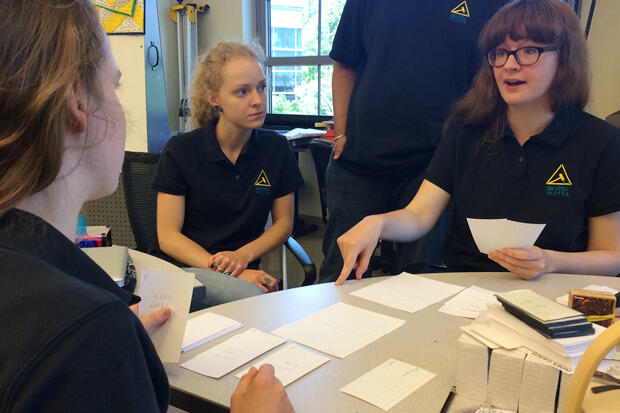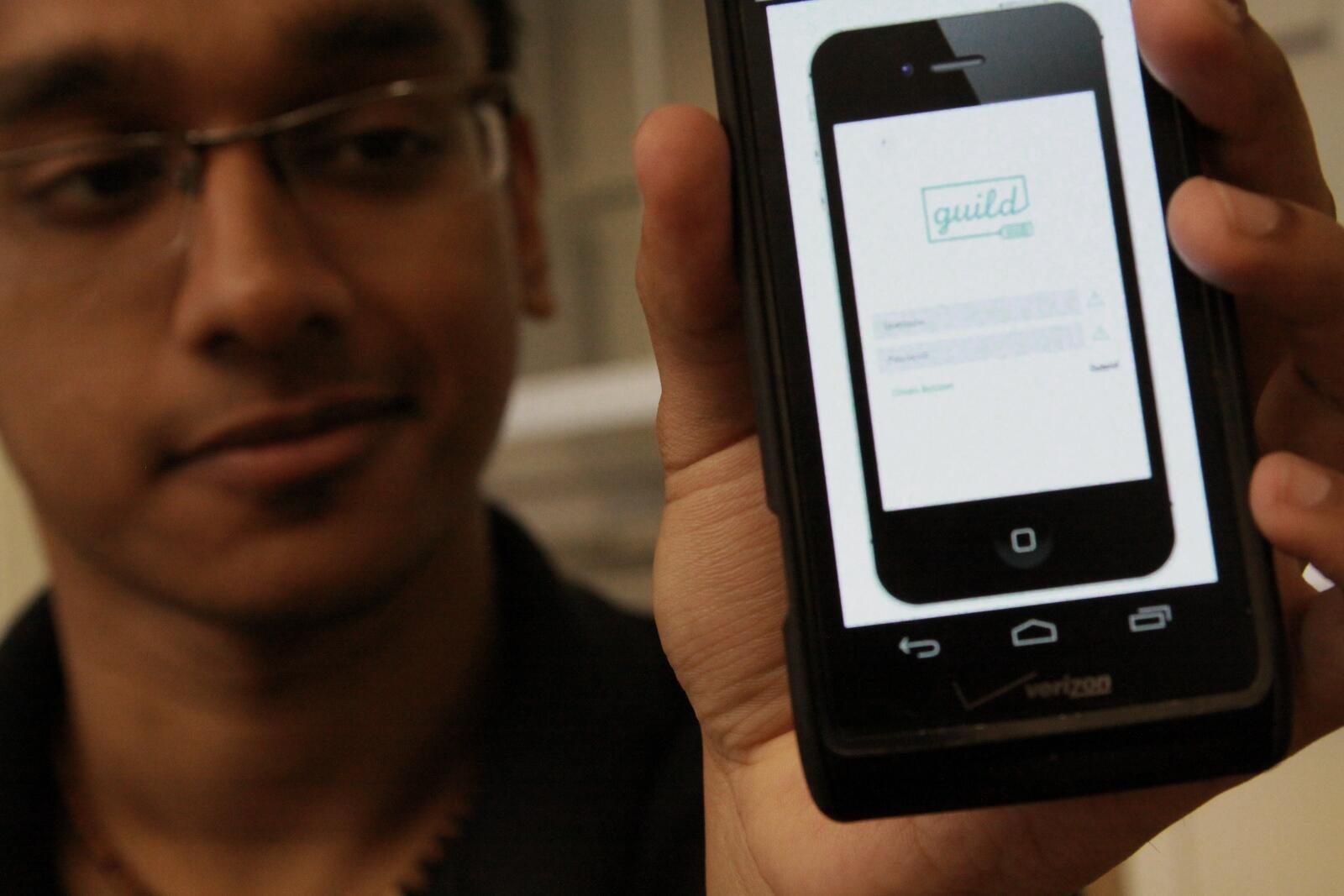
June 24, 2014
Summer course explores inventions' business potential
Share this story
In one corner of Room 4229 of Virginia Commonwealth University's Engineering East Hall, a team of VCU students is inspecting a small 3-D printed object, its shape based on the contours of Thomas Jefferson's silhouette.
In another corner, three students are testing a competitive card game they designed — similar to Magic: The Gathering — that aims to teach cellular biology to middle schoolers, while also being fun to play.
In yet another, two VCU students are piecing together a quilt-making kit, which they hope will allow anyone to assemble a high-quality quilt without the need for a sewing machine or even any sewing experience.
The students are taking part in da Vinci Works, an interdisciplinary summer program in which five teams of VCU students investigate the viability of launching startup companies focused on specific inventions or innovations.
"What we’re trying to do is have the students test drive these ideas and see if there would be a market for them," said Russ Jamison, Ph.D., director of da Vinci Works and a professor in VCU's School of Engineering.
The da Vinci Works program, he said, is an intensive, six-week dive into making and testing prototypes of product ideas. It provides students with an opportunity to take an innovation idea, and focus on delivering something tangible, of real value to a customer, and with a price and a business model for delivering it.
"A place like VCU invents things every day. It’s really an engine of innovation," said Jamison, a professor of biomedical engineering and chemical and life sciences engineering. "But inventions that don't become commercial typically won’t reach the customer, and therefore will have minimal impact. Commercialization is the way that innovation ‘goes to market.’”
"The idea here," he added, "is to learn the tools of reducing ideas to practice, focusing on actual, rather than imagined, customer needs in the process."
3-D printed silhouettes

The team working on the 3-D-printed silhouettes, based on a scan of a person's profile, is exploring the business opportunities of selling the objects as mementos, based on the silhouette of, say, a person's child or grandchild.
"People used to do bronzed baby shoes. This is kind of like that," said Kristina Hendel, a senior biomedical engineering student. "We're thinking maybe this could be the next thing that people give as gifts."
During a recent visit, the team was working on creating 3-D objects based on the contours of their classmates' faces.
"Right now we're working on examples from our class," said Rachel Hume, a junior communication arts student from the School of the Arts. "So we take photographs of people in here. We use commercially available imaging and solid modeling tools to build 3-D computer models. We then use another commercial software tool that allows us to 3-D print it right here."
The team realized early in the process that if you shine a light at the object, its shadow will create a profile image of the person.
"It's like a piece of art, essentially," Hume said. "We're looking at parents and others who might want a keepsake of their loved ones. And we're also looking at art collectors."
Jamison said the idea was to investigate whether a business could be built around low-cost 3-D printing.
"We have in this room two 3-D printers. Both are in operation all day, every day," he said. "Now that they are affordable — around $3,000 — we wanted to see, what could you do with them to create unique products with commercial value?"
Guild, an iPhone app for small businesses

Another team, led by class teaching assistant, Munif Saza, a recent biomedical engineering graduate, is developing an iPhone app that aims to link small business owners and entrepreneurs with freelance service providers, such as graphic designers, web developers and marketing professionals.
"Entrepreneurs are in need of people who can create their website, design their business cards and so on," he said. "They find these people usually through one of two means. They contact a big company that charges a premium price. Or they find someone who can do the job through word of mouth."
The team's app, Guild, will match business owners with the service providers in their area.
"It was imagined that if we could make an app that finds the best match for you — almost like a dating service — in your locale, you could make a match, meet up for coffee and get to work," he said.
The idea for the app grew out of an independent study course led by Jamison in 2013 that included a number of students studying engineering, graphic design, illustration, computer science and psychology. Everyone on the team, except Saza, has since graduated and moved away from Richmond. They have continued to work on the project as a team for the past year, primarily through web-based conferencing tools.
Saza and his teammates formed a company, Inkathink LLC, that is developing the app, which they hope will launch in September.
Bioenergetics

The team developing the card game is part of a larger VCU project to educate young children and their families about the importance of improving nutrition and "bioenergetics," a field of biochemistry concerned with how energy flows through living systems.
The project, led by Shilpa Iyer, Ph.D., a professor in VCU's Department of Chemical and Life Science Engineering, is supported by a Quest Innovation Fund grant. As part of the grant, faculty and students from the schools of the arts and engineering are creating educational modules that teach about a variety of disorders related to energy failure.
"You know how you're supposed to eat right and exercise? Well, the scientific reason for that is that when you eat well and you exercise, your body has these tiny little organelles called mitochondria that produce your energy. And when you don't eat right and don't exercise, you don't produce that energy so you feel lethargic and you don't want to exercise," said Gwendolyn Wood, a graduate of VCU's Department of Communication Arts.
"But when you do healthy things like eating and exercising correctly, your body makes more mitochondria so you have more energy and you feel better," she continued. "So regardless of weight or anything like that, the better you eat, the more you exercise, the better you feel."
The da Vinci Works team is creating a three-part tool kit on cellular biology — with an emphasis on mitochondria — for seventh-grade teachers. One part will be a giant cell that the class can build to see the different parts. Another will be a personality quiz — "What organelle are you?" The third will be the card game.
"You have your cell, and you add mitochondria for attack and cell walls for defense. And you basically hash it out," Wood said.
"We're also going to add more interesting cards to shake it up," said Katy Marchese, a senior in the Department of Communication Arts. "We're going to add cards that are like chance cards. They'll have things like, oh your mitochondria has conjured a disease and now you're at 50 percent capacity."
The idea, she said, is that the game will be a fun way to learn about the importance of healthy living and the role of mitochondria.
3-D printed ceramic
Nitin Panwar, a senior biomedical engineering student, is part of a team building a 3-D printer that prints ceramic instead of plastic.
"The short-term goal of this project is to build a printer in one week," he said. "The longer-term goal is to explore industrial and artistic applications for it."
Panwar's team is basing their printer off a design created by an artist in England, Jonathan Keep, who made the design open source. They're working to fine-tune the design and to identify U.S suppliers for all of the parts required to build future printers.
"We want to see how well it works and we want to see if we can't make some improvements to the design," he said. "We have a team of engineering and art students — and we want to get ideas from both as to how we can improve the mechanical aspects of the printer and of the clay being used."
Quilt-making kits

The team developing the quilt-making kits is aiming to produce a kit that allows someone to assemble a quilt in fewer than eight hours with no prior sewing experience and no physical sewing machine.
"The idea is that people create these ravioli-like squares, which can be assembled by making loops [along each edge] and allowing the consumer to simply slide a piece of thread through to bind it," said student Desmund Delaney, a sophomore in financial engineering in the School of Business. "You'll be able to assemble a quilt without all of the tedious work."
Delaney and his teammate, Pooja Shah, a senior biomedical engineering student, said their target demographic is working women, age 25 to 45, who might not have the time needed to make a traditional quilt, but that still want to make a quilt as a nice keepsake or gift.
"It can be any size you want," Shah said. "We're working on deciding on a standard size for the squares, so depending on how many squares you put together will be how big your quilt will be."
Jamison said that the idea came out of an experimental innovation course he taught in the spring semester to 24 engineering students, in which they learned about a new approach to innovation called "Lean Startup" that requires teams to focus on unrecognized customer needs or "pain points."
“The working women we have talked to say that they want to make something they can enjoy both making and giving (think Pinterest) but don’t have the time or the skills," Jamison said. "A handmade quilt represents a link to mothers and grandmothers for many people we’ve talked to."
The importance of making things
The da Vinci Works program, Jamison said, is largely about giving students a chance to learn about the valuation and execution steps that come after the ideation step of innovation. “There are many ideas that simply languish because inventors do not have the knowledge and skill to complete these essential steps.”
"I'm a great believer in the idea that education has to have a tangibility to it, particularly engineering education, so that students experience both the challenges of making things and the satisfaction of making their ideas real," he said. "We’re trying to give students a sense that, yes, you can make that and know that others will want to buy it if you do."
Subscribe for free to the weekly VCU News email newsletter at http://newsletter.news.vcu.
Subscribe to VCU News
Subscribe to VCU News at newsletter.vcu.edu and receive a selection of stories, videos, photos, news clips and event listings in your inbox.




